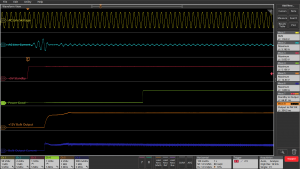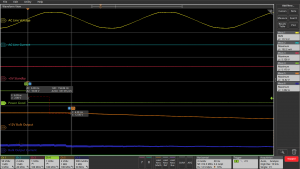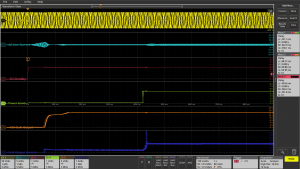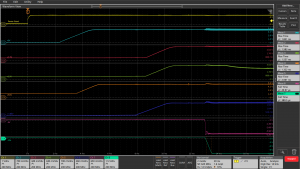
Speeding up power rail timing verification with an 8-channel oscilloscope
By Dave Pereles, technical marketing manager, Tektronix
Electronics Power Supply / Management Engineering oscilloscope oscilloscope power power power supply power supply rail rail timing timingMost electronics systems today use more than one power rail and many use four or more. A single IC, such as an FPGA, DSP or microcontroller can require several power rails, and these may have specific timing requirements. For example, a chip manufacturer may recommend that the core voltage supply stabilize before the I/O supply voltage is applied. Or, a manufacturer may require that supplies come up within a specified time relative to each other to avoid prolonged voltage differences on various supply pins. The power-on sequence between processors and external memory can also be critical.

Figure 1: This screen shot shows measurement of an AC/DC switching power supply turn-on after the front-panel switch was pressed.
Chip manufacturers may specify that particular supplies must come up monotonically to avoid multiple power-on resets. This can be challenging since inrush currents can place high transient demands on point of load regulators. In this case the shape of power rail startup is as important as the timing sequence. Once you combine the various chip supply requirements, bulk supplies, reference supplies and multiple point-of-load regulators for other ICs in a design, you can get up to seven or eight power rails in a hurry.
Using a 4-channel oscilloscope to verify power rail timing in an embedded system can be time-consuming, but this is how most engineers do it currently. In this article, we’ll first look at why this can be challenging with a 4-channel scope for this purpose, and then we’ll show a few examples using an 8-channel scope, which have becoming increasingly more common across the industry.

Figure 2: A waveform cursor measurement can be used to verify that the PW OK pre-warning signal is operating as specified.
Traditional 4-channel oscilloscope
One approach when using a 4-channel oscilloscope is to analyze the power system in blocks and using multiple acquisitions to check the timing block by block. To compare between blocks, one of the rails or a power good/fail signal can be used as a trigger and multiple captures can be taken, determining the startup and shutdown timing relative to the reference signal. Since acquisitions are taken over multiple power cycles, variations in the relative timing of supplies will be difficult to characterize. However, the range of variation of each supply from cycle-to-cycle can be determined by measuring over multiple power cycles using infinite persistence on the oscilloscope.
Another common approach is to ‘cascade’ multiple scopes. This is usually done by triggering the scopes on one of the power supplies or on a common power good/fail signal.

Figure 3: Repetitive turn-on timing measurements can be accomplished using infinite persistence and measurement statistics.
Both of these approaches are time-consuming and require special attention to synchronization:
- Dealing with synchronization and time uncertainty requires care
- Aggregating data to develop a system timing diagram is possible, but time-consuming
- Complexity increases with the number of power rails to be observed
- Setups must be perfectly consistent
- One measurement channel must be used to provide synchronization
A mixed signal oscilloscope can provide additional channels for power supply sequencing. For this to work, the MSO must have suitable voltage range on the digital inputs and independently adjustable thresholds. For example, a traditional MSO option offers 16 digital inputs with independent thresholds for each channel making it suitable for most of the voltage levels you’d find in a typical design. Note that this approach works well if the objective is strictly to measure timing relationships, but it does not allow for measurement of rise/fall times or the shape (monotonicity) of the power-on/off.
Using an oscilloscope with 8 analog channels cuts the time and hassle significantly versus any of the methods covered so far. With an 8-channel oscilloscope, power supplies with up to eight power rails can be characterized using analog probes. To measure turn-on and turn-off timing relationships on power supplies with more than eight power rails, a mixed signal oscilloscope with digital signal inputs and independently adjustable thresholds can also be used.

Figure 4: Rise- and fall-time measurements are shown in the results boxes on the right side of the display.
Turn-on delay
The switching power supply under test in Figure 1 produces a high-current, regulated 12Vdc output. This power supply is remotely controlled with a switch on the front panel of the instrument. Shortly after the switch is pressed, the +5V standby voltage is turned on, enabling the switching converter to start. After the +12V output is in regulation, the Power Good (PW OK) signal goes high to indicate to the load that the supply is reliable.
The +5V standby voltage signal provides a simple rising edge trigger for the acquisition of the relevant signals. Automatic measurements verify that the delay to the output voltage turn-on is <100ms, and the delay from output voltage turn-on to PW OK is in the specification range of 100 – 500ms.
Turn-off delay with remote on/off
After the power supply’s main switch is turned off, the switching converter is turned off and the output voltage decreases. The power supply is specified to remain in regulation for at least 20ms after the switch is pressed. Most importantly, the PW OK signal is specified to fall 5 – 7ms before the +12V output voltage falls out of regulation, allowing the load time to react and shut down cleanly. As shown in Figure 2, the PW OK signal provides a falling edge trigger for the acquisition of the relevant signals. The waveform cursor measurement verifies that the PW OK pre-warning signal is operating as specified.
Verify timing over multiple power cycles
To verify that the power supply turn-on timing remains within specifications over multiple power cycles, infinite persistence can be used to display the signal timing variations and statistics displays of automated timing measurements quantify the variations. In the setup in Figure 3, the 50 percent point of the +5V standby voltage serves as the timing reference. The turn-on sequence is repeated 10 times and the timing variations over the 10 turn-on cycles are within a little over 1%.
Power supply rise-time measurements
In addition to the power supply sequencing, the rise-times of power supplies must be controlled to meet the specifications of some critical components in a system. Automated rise- and fall-time measurements are also made based on voltage reference points which are, by default, automatically calculated to be 10% and 90% of the signal amplitude of each channel. In the example in Figure 4, the rise-times of the positive supplies and the fall-times of the negative supplies are shown in the results boxes on the right side of the display.
The proliferation of power rails in today’s systems presents a significant test and measurement challenge. To optimize for power consumption, performance and speed, even a relatively simple system can have a 12V bulk supply, a couple of 5V supplies, a 3.3V supply and a 1.8V supply. Verifying and troubleshooting the turn-on and turn-off sequence of these supplies can be more efficiently accomplished using oscilloscopes that offer more than the traditional 4 channels.
